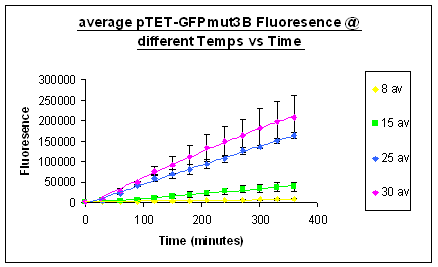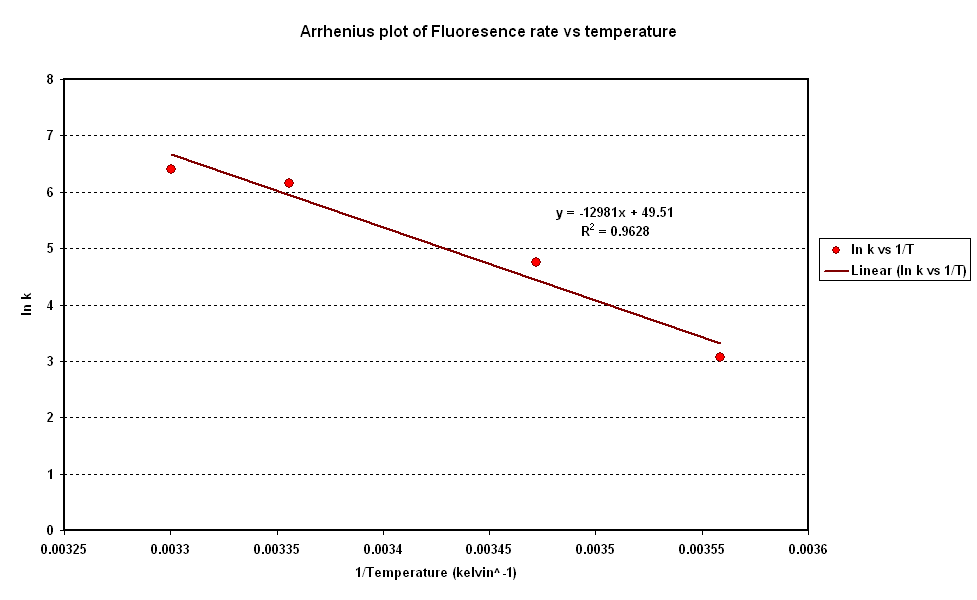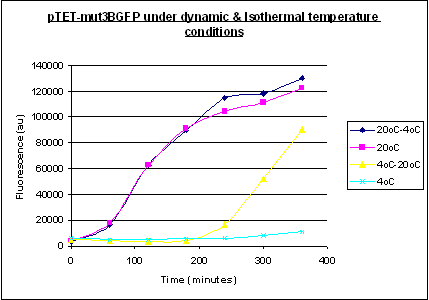Imperial/Cell by Date/Testing
From 2007.igem.org
m |
m (→Validation and Conclusion) |
||
| Line 60: | Line 60: | ||
==Validation and Conclusion== | ==Validation and Conclusion== | ||
| - | |||
| - | |||
| - | |||
| - | |||
| - | |||
| - | |||
| - | |||
| - | |||
| - | |||
| - | |||
| - | |||
| - | |||
| - | |||
| - | |||
| - | |||
| - | |||
| - | |||
| - | |||
| - | |||
| - | |||
| - | |||
| - | |||
| - | |||
| - | |||
| - | |||
| - | |||
| - | |||
| - | |||
| - | |||
| - | |||
| - | |||
| - | |||
| - | |||
| - | |||
| - | |||
| - | |||
| - | |||
| - | |||
| - | |||
Revision as of 18:23, 26 October 2007

Cell by Date: Testing
Testing and Discussion
Investigation properties of system under isothermal scenarios
To estimate the properties of our system we looked at the evolution of the Fluorescence with time for experiments where temperature is carefully kept constant. (Figure 1).
General Behaviour:
- In all experiment we can observe a linear growth of fluorescence corresponding to a steady rate of protein production.
- This matches the claims of the manufacturer of the cell-free extract that the extract is optimised so that protein degradation is negligible.
Operating Range:
- Our system seems to 'turn off' at around 4 degrees C.
- At 8 degrees with have minimal expression which then increases to a substantial expression at 37 degrees.
Synthesis rate vs Temperature
- Over the range of temperature considered here the rate increases with temperature.
- To investigate the relation between synthesis rate and temperature we extracted the rate of synthesis of GFP for each experiment and plotted it against 1/T (Figure 2).
- A strong linear correlation in the log plot supports an arrhenius type dependence on temperature with an activation energy of 1.5kJ/mol.
Other practical considerations:
- Unfortunetly we have not been able to use a visible reporter and so have no idea whether the construct can in fact produce a visible signal.
- In terms of lifespan we have had major problems with evaporation meaning that the lifespan of our system is limited to a few days.
dirkadirak everything aftther this is not what matthieu sent me
In order to investigate the properties of our system we began by looking at isothermal scenarios in order to determine primarily the activation energy of our sytem following Giannuzzi's work with beef. Again this is useful because as per Taoukis' research for a TTI to function correctly its activation energy needs to be close to the target product. In Figure 1 above we see that under isothermal conditions a steady rate of fluoresence was observed, corresponding to a steady rate of protein production. This rate increase with temperature as per our predictions as protein production is linked to the kinetics of translation and so temperature. We have been able to extract the rate of protein production for range of temperature and made an arrhenius plot to further explore translation kinetics. A strong linear correlation in the log plot seems to suggest that an arrhenius type dependance on temperature seems to fit the translation mechanism. From this we have been able to calculate the activation energy as 1.5kJ/mol.
In addtion to calculating the activation energy through these experiments we have also been able to determine the operating range of our system. Our system seems to 'turn off' at around 4 degrees C. At 8 degrees with have minimal expression which then increases to a substantial expression at 37 degrees. Unfortunetly we have not been able to use a visible reporter and so have no idea whether the construct can in fact produce a visible signal. In terms of lifespan we have had major problems with evaporation meaning that the lifespan of our system is limited to a few days.
Investigation System properties under Dynamic Temperature Conditions
Response time extraction still to do


